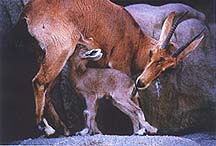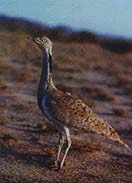by Iyad Nader
Pictures by NCWCD/MEPPS
CLICK ON MAP FOR ENLARGEMENT (54k JPEG)
 Over recent years there has been a marked change in public attitudes
towards wildlife conservation in Arabia. Every country on the
peninsula has made a concerted effort to educate its people about
the need to care for nature and respect the environment in which
they live. The process of education is now entering a new phase
in which the public are encouraged to take an interest in the
work of different conservation bodies. At the National Commission
for Wildlife Conservation and Development, based at Riyadh in
Saudi Arabia, a new Centre for Environmental Awareness has been
built. Arabian Wildlife asked Dr Iyad Nader, who is responsible
for the day to day management of the centre, to give the background
to the project.
Over recent years there has been a marked change in public attitudes
towards wildlife conservation in Arabia. Every country on the
peninsula has made a concerted effort to educate its people about
the need to care for nature and respect the environment in which
they live. The process of education is now entering a new phase
in which the public are encouraged to take an interest in the
work of different conservation bodies. At the National Commission
for Wildlife Conservation and Development, based at Riyadh in
Saudi Arabia, a new Centre for Environmental Awareness has been
built. Arabian Wildlife asked Dr Iyad Nader, who is responsible
for the day to day management of the centre, to give the background
to the project. There can be no doubt that development depends upon the proper
conservation of natural resources for the benefit of present and
future generations. In order to make the public aware of the danger
facing some of the wildlife habitats and wildlife in the Kingdom
of Saudi Arabia, a Visitors Centre for Environmental Awareness
was established by the NCWCD under the guidance of HRH Prince
Saud al-Faisal, managing director of the Commission. The project's
development was co-ordinated by NCWCD Secretary General, Dr. Abdulaziz
Abuzinada.
There can be no doubt that development depends upon the proper
conservation of natural resources for the benefit of present and
future generations. In order to make the public aware of the danger
facing some of the wildlife habitats and wildlife in the Kingdom
of Saudi Arabia, a Visitors Centre for Environmental Awareness
was established by the NCWCD under the guidance of HRH Prince
Saud al-Faisal, managing director of the Commission. The project's
development was co-ordinated by NCWCD Secretary General, Dr. Abdulaziz
Abuzinada.
Official inauguration of the Visitors Centre was on 27 February 1990 when HRH Prince Sultan Bin Abdulaziz, Second Deputy Prime Minister, Minister of Defence and Aviation, Inspector General and Chairman of the Board of Directors of NCWCD visited the centre and declared it open.
Different exhibits in the Centre illustrate and emphasise the role, activities and achievements of the Commission in the field of environmental protection and wildlife conservation. It is not intended to be a museum in its own right but does mark the first step towards implementation of the Commission's plan to establish a National Museum of Natural History.
It is the first facility of its kind in Saudi Arabia and displays a wide range of natural habitats. In line with the Commission's general approach towards conservation, the prime focus is on natural habitats rather than individual species but since each habitat has its characteristic species, the displays also portray important animals and plants associated with various ecosystems.
Located within the grounds of the National Commission for Wildlife Conservation and Development's headquarters, the outer walls of the Centre are decorated with murals depicting 'rock-art' found in Saudi Arabia and drawn originally by people who lived here thousands of years ago. The animals in their ancient drawings certainly reflect the keen interest that our predecessors had in wildlife.
A brief tour of the Centre's exhibits begins with a display of the vast desert in the Empty Quarter where its characteristic inhabitant, the Arabian oryx, roamed freely until a few decades ago. The exhibit shows an adult male together with a younger oryx, both standing among their typical food-species of native desert plants. Fortunately, the clock is being set-back for the oryx which, although becoming extinct in the wild in 1972, now has a healthy population of animals with a considerable number back in the wild (see article in this issue).
Another major exhibit depicts loose reddish sands of the Great Nafud Desert where a graceful female reem or sand gazelle together with its young remind visitors of the importance of this desert region for survival of this and other Arabian species. The reem is one of three gazelle species still found in Saudi Arabia but numbers have declined, partly due to overhunting that occurred in the past. The Commission is engaged on a captive breeding programme with a view to reintroductions into protected reserves. At the time of writing, reem have been reintroduced to Mahazat As Said whilst idmi was released into the Ibex Reserve. There are over two hundred free-ranging gazelle in these two areas.
 But Saudi Arabia is by no means all sandy desert. Rocky sandstone
habitats are very important and one of the Commission's ten protected
areas comprises the sandstone outcrops of Hawta, located about
200 kms south-west of Riyadh, where an Ibex Reserve has been established.
The reserve contains a viable population of the Nubian ibex, Capra
ibex, which is shown in the exhibit of this habitat, together
with an idmi, or mountain gazelle, and a hardy and ubiquitous
brown-necked raven. The exhibit also features a desert pool with
several native plants found in this habitat.
But Saudi Arabia is by no means all sandy desert. Rocky sandstone
habitats are very important and one of the Commission's ten protected
areas comprises the sandstone outcrops of Hawta, located about
200 kms south-west of Riyadh, where an Ibex Reserve has been established.
The reserve contains a viable population of the Nubian ibex, Capra
ibex, which is shown in the exhibit of this habitat, together
with an idmi, or mountain gazelle, and a hardy and ubiquitous
brown-necked raven. The exhibit also features a desert pool with
several native plants found in this habitat.
In sharp contrast to the above natural environments, with their balanced ecosystems and wildlife, the next exhibit is intended to show what happens when Man's impact is unchecked. The fragile arid ecosystems of the desert are all too easily destroyed. Over-grazing and habitat destruction leave inedible and poisonous plants, dead animals, a criss-cross of vehicle tracks and the inevitable piles of unsightly and often harmful trash.
Sadly, the Arabian red-necked ostrich, largest of Arabia's birds, became extinct in 1940. Its cousin, the blue-necked ostrich, is exhibited as a mother bird with two chicks and four huge eggs. The Commission is breeding the ostrich with a view to its reintroduction to the wild at a future date.
Dense green vegetation with rich and varied plant and animal life, much of which has close affinities with African wildlife, is also found in Saudi Arabia, providing a stark contrast to its more widely recognised desert environment. Highland habitats of south-western parts of the Kingdom are depicted in a unique display that portrays a protected area of the Asir Region, the Raydah escarpment, located approximately ten kilometres north-west of Abha. This is the habitat of the Hamadryas baboon which is by far the most numerous large mammal in the western and south-western highlands. The species' population has grown as a result of increased food supply associated with garbage dumping and predator removal. Although it is good to see a wild animal such as the Hamadryas baboon flourishing, it is actually doing so because of a disturbed natural balance within the ecosystem.
The Kingdom's colourful and fascinating marine-life is displayed in two large closed circuit aquaria full of coral-reef fish and living corals. Great care has been taken to create a natural balance within the tanks which provide a compelling attraction for many visitors. Reef-fish, corals, sea-anemones, starfish, sea-urchins and other invertebrates all flourish in the marine aquaria. Open exhibits to each side of these live displays show the shy and rare marine-mammal, the dugong and a number of threatening (but also threatened) sharks.
The Centre also exhibits a range of other wildlife species including an interesting collection of insects, a few examples of lizards, snakes, birds of prey and game birds, in addition to a some smaller mammals. Saudi Arabia is a member of the Convention on International Trade in Endangered Species of Wild Flora and Fauna(CITES) and a display at the Centre shows how the Commission's education policy is directed at discouraging the public from buying, selling or in any way handling such species.
Man's relationship with the environment is depicted in a display entitled the Pyramid of Life. Photographs and illustrations are used to communicate basic ecological principles. Life in its varied forms depends upon plant-life and there is an inextricable inter-dependence between animal and plant-life. The pyramid of life is explained, starting with plants' photosynthesis and culminating in carnivores. Effects of over-grazing and habitat destruction on vegetation and their combined effects of unbalancing previous stable ecosystems are also graphically presented. This section of words and pictures rounds off with a display showing how wise use of natural resources will result in a balanced ecosystem in which the different elements co-exist harmoniously. It emphasises that an unbalanced habitat will ultimately affect man himself.
The Centre has gained considerable popularity since it was opened. In addition to regular visitors, prearranged tours by groups, mainly school children, are conducted daily throughout the academic year. The Centre is open during office hours, Saturday to Wednesday, and visits can be arranged through the office of the Secretary General of the NCWCD.
Web Links | Subjects | Search
Arabian Wildlife. Volume 1, Number 1